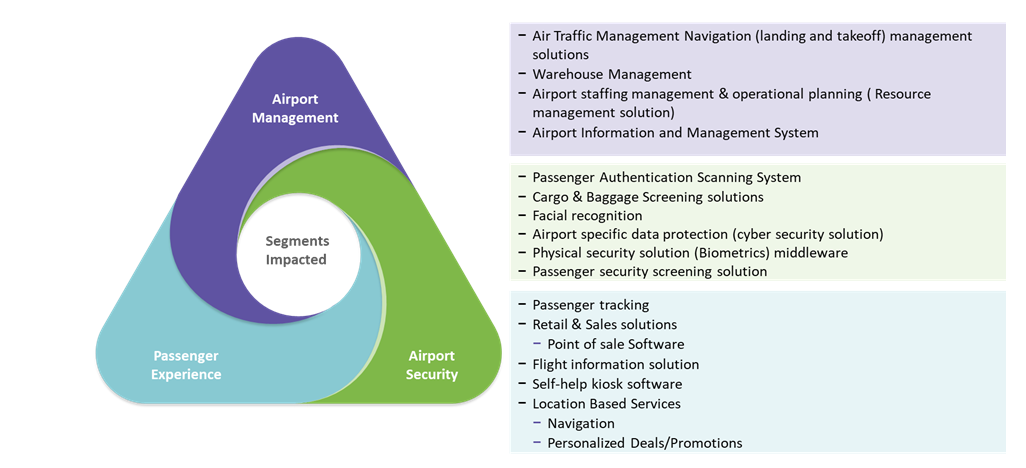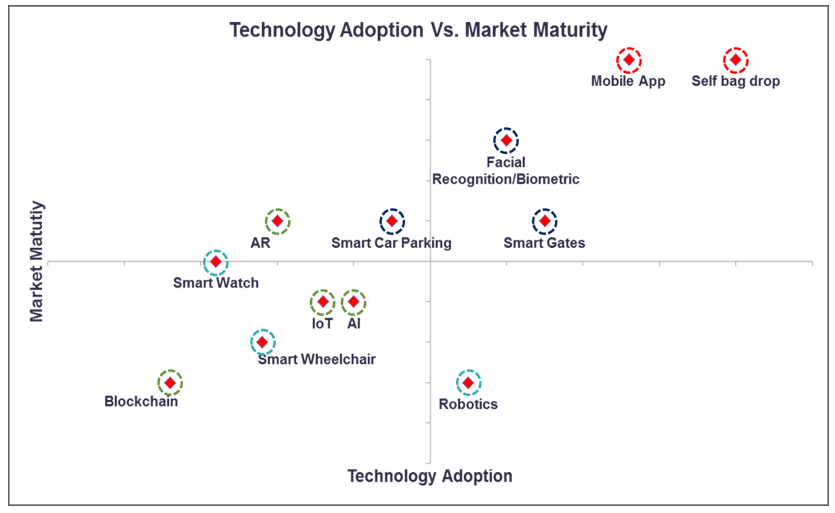
Proliferation of Innovative Technologies in the Airport Industry

Rise of Technology Adoption in Airports
A wide array of technological systems is being deployed across various areas in airports. These systems aim to improve customer experience and increase the number of data collection touch points and the ease of airport maintenance. The three key segments impacted by technology advancements are airport security, airport management, and passenger experience.
Technology Landscape in Airports
Biometric Technology Trials
Robust Technologies
Our analysis revealed the widespread adoption of the self-bag drop system and mobile app at major airports. These technologies contribute toward the provision of location-based services, personalized offers, navigation, and travel information, among others, and thereby improve customer experience and minimize passenger waiting time.
Benefits
-
Cut loading time from 60 minutes to around 45 minutes
-
Cut the boarding and transit time of passengers by 15 minutes.
Biometric Technology Trials
We also observed the eagerness of airports to deploy facial recognition/biometric technology and smart eGates to reduce manual intervention and clearance time per passengers at immigration checkpoints. However, ranging from 95 percent to 99 percent, the accuracy rate of these technologies is posing a concern.
Benefits
In 10 secs, the system can verify whether a passenger’s passport photos match the passenger’s image taken by cameras installed at the gates.
Innovative Technologies
Airports are trying to adopt technologies such as artificial intelligence(AI)-based robotics, smart wheel chair/vehicles for passengers, and smart watch for staff; they aim to improve passenger experience as well as the efficiency of the airport staff.
Benefits
Airports can use sensors to measure the distance between the aircraft tugs, which are used to push the aircraft from the gate to the takeoff apron. The data collected from these sensors have saved 90 sec of aircraft taxiing time per flight during peak hours.
Disruptive Technologies
Key technologies like blockchain, AI, augmented reality (AR), and the Internet of things can change the dynamics of airport operations. However, these technologies are in the development phase and limited airports are using these on a trial or pilot basis.
Benefits
Previously, the arrival timings of flights were predicted only 30 minutes to 1 hour before the flight’s expected arrival. However, the aforementioned technologies have made it possible to predict flight time 2 hours before their expected arrival. This can contribute toward improving a range of post-flight operations, from gate planning to arrival queues
Technology Adoption Vs. Market Maturity
The below graph shows the adoption of airport management technologies and their maturity in airport industry. We have rated the adoption on a scale of 1 to 5, where a rating of 5 indicates high adoption/maturity and 1 indicates low adoption/maturity.
Key Trends
- Biometrics
Airports are progressing with the adoption of the biometric-enabled “single passenger token,” solution to improve airport security and avoid multiple security checkpoints. Biometrics can be integrated into signage and flight information display systems (FIDS) to provide personalized information and offers. Biometric sensors have been used to collect health-related data of passengers. For example, these sensors can measure the temperature of patients returning from infected countries and contribute toward quarantine decisions. These sensors can also monitor speed/movement of passengers
- Smart Parking
Smart parking helps in reducing parking time as well as emissions and providing a hassle-free parking experience. For example, smart parking shows real time availability of slots. Sensors placed in parking slots provide real-time information to passengers either through displays or mobile applications. These sensors provide information on the driving distance to parking spot, size of the parking spot, and proximity to entry terminals. Billing for the same is carried out through an application based on license plate recognition systems integrated with the parking systems. This results in a hassle free and personalized customer experience.
- Artificial Intelligence, Robots, and Augmented Reality (AR)
AI can help airports to predict potential criminal or terrorist behavior; additionally, in the area of baggage, individual baggage transportation robots can be used for baggage handling. AR can be deployed to improve customer experience and track passenger movements, such as their movements to and from the most visited places.
- Blockchain
Geneva Airport, Heathrow Airport, and the Miami International Airport provide live updates of certain stages of the journey. Airports can use blockchain to update the flight data of a passenger; for example, passenger’s arrival and departure information can be collected from the passenger’s arrival and departure airports, respectively.
Conclusion
Airports are increasingly deploying advanced technological solutions. Top airports, such as Changi, Incheon, Haneda, Hong Kong International Airport, Hamad, Munich, and Heathrow, are at different stages of technology deployment. The adoption of these technologies have already contributed toward tangible and intangible benefits.
Related Insights:
View All
Get more stories like this
Subscirbe for more news,updates and insights from Beroe













G